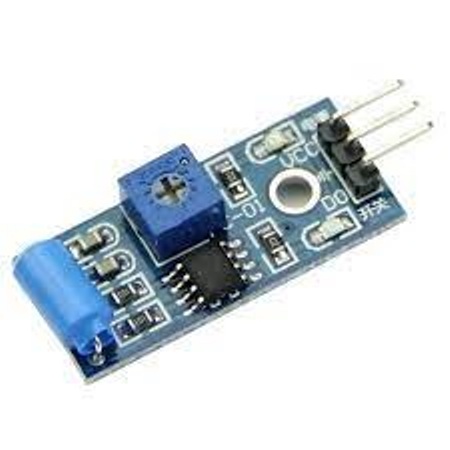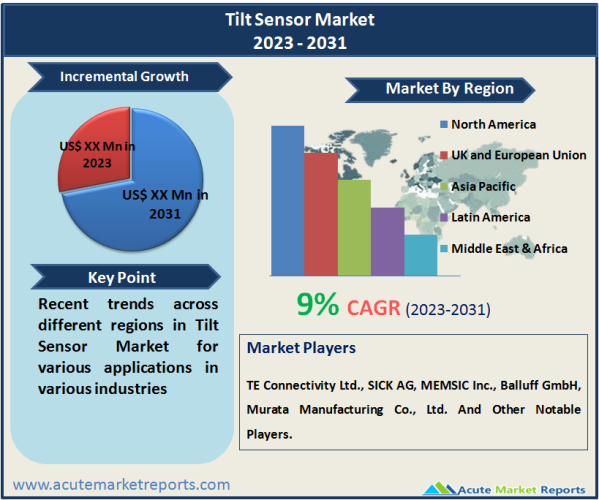
The tilt sensor market is expected to witness a CAGR of 9% during the forecast period of 2025 to 2033, driven by various factors such as technological advancements, increasing applications in various industries, and rising demand for safety and stability systems. In this comprehensive overview, we will explore three primary drivers that have contributed to the market's expansion, as well as one major restraint that has posed challenges. Additionally, we will analyze the market segmentation by housing material type and technology outlook, followed by a detailed examination of the geographic segment and competitive trends among top players.

Increasing Automation and Robotics
The tilt sensor market has been strongly driven by the increasing adoption of automation and robotics across industries. As industries seek to improve productivity, efficiency, and safety, the integration of tilt sensors has become crucial. These sensors play a vital role in ensuring the accurate positioning and orientation of robotic arms, machinery, and various automation systems. They enable real-time monitoring of tilt angles, ensuring precise movements and reducing the risk of accidents and collisions. In applications such as construction, automotive manufacturing, and aerospace, where precision is critical, tilt sensors are extensively utilized to enhance operational efficiency and maintain safety standards. With the continuous advancements in robotics and automation technologies, the demand for tilt sensors is expected to grow further, contributing to the market's expansion.
Growing Demand for IoT-enabled Devices
The proliferation of the Internet of Things (IoT) has had a significant impact on the tilt sensor market. IoT-enabled devices are becoming increasingly popular across various sectors, including automotive, consumer electronics, and healthcare. Tilt sensors, when integrated with IoT technology, offer enhanced functionalities and capabilities, such as remote monitoring, data analytics, and predictive maintenance. In the automotive industry, IoT-enabled tilt sensors are utilized in vehicle stability systems and anti-roll systems, improving driving safety and comfort. Similarly, in consumer electronics, tilt sensors enable innovative features in smartphones and tablets, such as auto-rotate screens and gaming motion controls. Moreover, in the healthcare sector, IoT-enabled tilt sensors are used in medical equipment and wearable devices, contributing to the growth of telemedicine and remote patient monitoring. The rising demand for IoT-enabled devices across various industries is expected to drive the growth of the tilt sensor market during the forecast period.
Increasing Applications in Aerospace and Defense
The aerospace and defense sector has emerged as a significant driver for the tilt sensor market. Tilt sensors play a critical role in various aerospace applications, such as aircraft attitude and heading reference systems (AHRS), flight control systems, and unmanned aerial vehicles (UAVs). These sensors provide real-time data on aircraft orientation, helping pilots and autopilot systems maintain stability and make precise maneuvers. In the defense sector, tilt sensors are utilized in military vehicles, artillery systems, and missile guidance systems, ensuring accuracy and optimal performance. With the growing investments in aerospace and defense technologies worldwide, the demand for tilt sensors in these sectors is expected to witness substantial growth during the forecast period, bolstering the overall market expansion.
High Costs and Limited Calibration
One major restraint that has affected the tilt sensor market is the relatively high costs associated with advanced tilt sensor technologies. The development and implementation of high-precision tilt sensors involve significant research and manufacturing expenses, which, in turn, increase the overall production cost of tilt sensor devices. Additionally, the calibration process for tilt sensors can be complex and time-consuming, leading to operational delays and increased maintenance costs. Furthermore, calibration is essential to ensure accurate readings and reliable performance, but limited access to calibration facilities in some regions poses a challenge to the widespread adoption of tilt sensors. To address this restraint, manufacturers are focusing on developing cost-effective, reliable, and self-calibrating tilt sensor solutions, which are expected to become more accessible and affordable during the forecast period.
Market Segmentation by Housing Material Type: Metal Housing to Lead the Growth
In terms of housing material type, the tilt sensor market can be categorized into metal, plastic, and others. The metal housing segment is expected to witness the highest CAGR during the forecast period of 2025 to 2033. Metal housings offer superior durability and protection, making them ideal for rugged environments and harsh conditions. Furthermore, metal housing tilt sensors find extensive applications in industries such as automotive, construction, and aerospace, where reliability and resilience are crucial. As a result, the metal housing type is anticipated to lead the growth during the forecast period, owing to its widespread adoption in critical applications.
Market Segmentation by Technology Outlook: MEMS Tilt Sensor Segment to Lead the Growth
Based on the technology outlook, the tilt sensor market can be segmented into MEMS (Micro-Electro-Mechanical Systems) and fluid-based tilt sensors. The MEMS tilt sensor segment is expected to register the highest CAGR during the forecast period of 2025 to 2033. MEMS tilt sensors offer several advantages, including compact size, low power consumption, and high accuracy. These features have made MEMS tilt sensors popular across various industries, including consumer electronics, automotive, and healthcare. Moreover, the increasing adoption of MEMS technology in consumer devices such as smartphones, tablets, and gaming consoles is expected to drive the growth of this segment. Consequently, the MEMS tilt sensor segment is likely to contribute significantly to the market's revenue during the forecast period.
North America Remains as the Global Leader
North America is expected to be the leading market for tilt sensors in terms of revenue generation in 2024. The region's dominance can be attributed to the presence of major aerospace and defense industries, as well as the significant adoption of automation and robotics across various sectors. Furthermore, the rising demand for IoT-enabled devices in North America, coupled with technological advancements, is driving the growth of the tilt sensor market in the region. Meanwhile, the Asia-Pacific region is anticipated to experience the highest CAGR during the forecast period. Factors such as rapid industrialization, growing automotive and consumer electronics industries, and increasing investments in aerospace and defense technologies are fueling the demand for tilt sensors in the region. Additionally, the emergence of various start-ups and local manufacturers offering cost-effective tilt sensor solutions is further contributing to the market's growth in the Asia-Pacific region.
Market Competition to Intensify during the Forecast Period
The tilt sensor market is highly competitive, with several key players vying for market share. Some of the top players in the market include TE Connectivity Ltd., SICK AG, MEMSIC Inc., Balluff GmbH, and Murata Manufacturing Co., Ltd. These companies have a strong global presence and offer a wide range of tilt sensor products catering to various industries and applications. To maintain their competitive edge, these players focus on product innovation, research and development, and strategic partnerships. Additionally, they are actively expanding their product portfolios to offer a comprehensive range of tilt sensors with varying features and capabilities. Moreover, these companies are investing in marketing and promotional activities to increase their market visibility and customer reach. As of 2025, the tilt sensor market has witnessed significant growth, and these top players have capitalized on the market opportunities. Looking ahead to the forecast period from 2025 to 2033, it is expected that these players will continue to dominate the market and drive its growth through continued innovation and strategic initiatives.
Historical & Forecast Period
This study report represents analysis of each segment from 2023 to 2033 considering 2024 as the base year. Compounded Annual Growth Rate (CAGR) for each of the respective segments estimated for the forecast period of 2025 to 2033.
The current report comprises of quantitative market estimations for each micro market for every geographical region and qualitative market analysis such as micro and macro environment analysis, market trends, competitive intelligence, segment analysis, porters five force model, top winning strategies, top investment markets, emerging trends and technological analysis, case studies, strategic conclusions and recommendations and other key market insights.
Research Methodology
The complete research study was conducted in three phases, namely: secondary research, primary research, and expert panel review. key data point that enables the estimation of Tilt Sensor market are as follows:
Market forecast was performed through proprietary software that analyzes various qualitative and quantitative factors. Growth rate and CAGR were estimated through intensive secondary and primary research. Data triangulation across various data points provides accuracy across various analyzed market segments in the report. Application of both top down and bottom-up approach for validation of market estimation assures logical, methodical and mathematical consistency of the quantitative data.
| ATTRIBUTE | DETAILS |
|---|---|
| Research Period | 2023-2033 |
| Base Year | 2024 |
| Forecast Period | 2025-2033 |
| Historical Year | 2023 |
| Unit | USD Million |
| Segmentation | |
Housing Material Type
| |
Technology
| |
Application
| |
|
Region Segment (2023-2033; US$ Million)
|
Key questions answered in this report